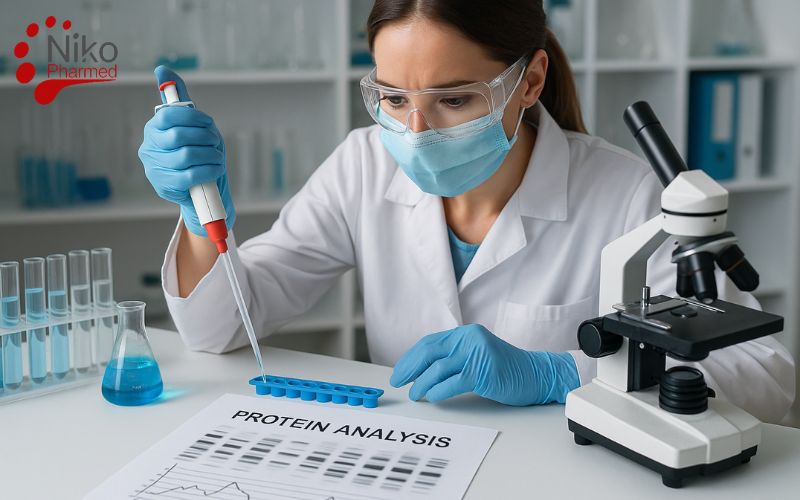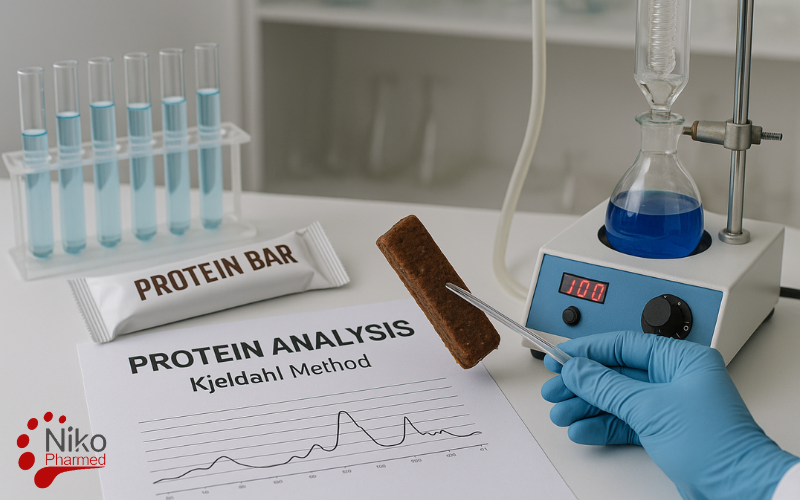What is Protein Analysis?
Protein analysis, is the determination of the protein content in a given sample, such as a meal, dietary supplement, or raw ingredient. This process involves quantifying the total amount of protein present, typically by measuring nitrogen content. Precise protein analysis is essential for determining the nutritional value of foods, validating product labeling, and assessing the quality of protein-based supplements.
Measuring protein concentration enables researchers and manufacturers to establish a product’s dietary contribution, maintain compliance with regulatory requirements, and supply consumers with accurate information about their protein intake to support health, athletic performance, and clinical nutrition.
In classical proximate analysis of foods, feeds and nutraceuticals, protein content is typically interpreted together with moisture content analysis and fat analysis to build the core nutritional profile used for labeling, process optimisation and quality control.
Protein Analysis Test Methods
The major methods standardized by organizations such as the AOAC (Association of Official Analytical Collaboration), ISO (International Organization for Standardization), and Codex Alimentarius include the Kjeldahl method, the Dumas (combustion) method, and amino acid analysis.
Kjeldahl Method (AOAC 2001.11, ISO 8968)
The Kjeldahl method is the classical and most widely accepted technique for determining total protein content. It measures organic nitrogen in the sample and converts it into protein using a nitrogen-to-protein conversion factor (commonly 6.25 for mixed foods). The process involves three key steps:
- Digestion – The sample is digested with concentrated sulfuric acid and a catalyst, converting organic nitrogen into ammonium sulfate.
- Distillation – The digest is neutralized with alkali, releasing ammonia, which is distilled into a boric acid solution.
- Titration – The ammonia is quantified by titration with a standard acid.
This method is highly reliable and recognized as a reference method in food labeling and trade regulations. However, it does not distinguish between protein nitrogen and non-protein nitrogen, which may slightly overestimate true protein content.
Dumas (Combustion) Method (AOAC 992.23, ISO 16634)
The Dumas method, also known as the combustion method, is a modern alternative to Kjeldahl, offering faster and more automated protein determination. The sample is combusted at high temperatures (≈900 °C) in the presence of oxygen, converting nitrogen into nitrogen gas (N₂).
The gas is separated and measured using a thermal conductivity detector, and protein content is calculated using the same nitrogen-to-protein conversion factor.
This method is rapid (minutes vs. hours for Kjeldahl), requires no hazardous chemicals, and is suitable for high-throughput laboratories. It is recognized by AOAC and ISO as an official method. Like Kjeldahl, however, it measures total nitrogen and may not differentiate true protein from non-protein nitrogen.
Amino Acid Analysis (AAA) (ISO 13903, AOAC 982.30)
Amino acid analysis is considered the gold standard for determining true protein content and quality. It directly measures the amino acid composition of proteins after hydrolysis of the sample (typically with 6N hydrochloric acid at 110 °C for 24 hours). The amino acids are then separated and quantified using chromatography methods (ion-exchange, HPLC, or UPLC).
This method provides precise information on:
- Total protein content (sum of amino acids).
- Amino acid profile (essential vs. non-essential amino acids).
- Protein quality (biological value, digestibility, etc.).
Although highly accurate, amino acid analysis is more labor-intensive, costly, and time-consuming compared to Kjeldahl or Dumas.
Protein Analysis Test Methods Comparison
| Method | Principle | Standards (AOAC / ISO) | Advantages | Limitations | Applications |
|---|---|---|---|---|---|
| Kjeldahl Method | Digestion of organic nitrogen with sulfuric acid → conversion to ammonium → distillation and titration → protein calculated using N-to-protein factor. | AOAC 2001.11, ISO 8968 | – Recognized as reference method- High accuracy- Widely accepted for labeling & trade | – Time-consuming (hours)- Uses hazardous chemicals (H₂SO₄)- Measures total nitrogen (includes non-protein nitrogen) | Official food labeling, regulatory compliance, reference standard in trade |
| Dumas Method | High-temperature combustion converts nitrogen into N₂ gas → measured by thermal conductivity detector → protein calculated using conversion factor. | AOAC 992.23, ISO 16634 | – Very fast (minutes)- Automated, high throughput- No hazardous chemicals | – Expensive equipment- Measures total nitrogen (non-protein nitrogen included)- Slightly less accepted as reference vs. Kjeldahl | Routine protein analysis in food/supplement industries, quality control |
| Amino Acid Analysis | Hydrolysis of proteins into amino acids → separation & quantification (HPLC/UPLC) → total and individual amino acids measured. | AOAC 982.30, ISO 13903 | – Most accurate- Measures true protein- Provides amino acid profile & quality assessment | – Very costly and labor-intensive- Time-consuming (hydrolysis takes ~24 h)- Requires skilled operation | Research, protein quality evaluation, clinical nutrition studies, high-value supplements |
Nikopharmed Protein Analysis laboratory
Global Recognition
ISO/IEC 17025-certified and ILAC-accredited, Nikopharmed provides protein analysis data accepted worldwide by FDA, EMA, and other regulatory bodies.
Technical Excellence
We deliver GLP-compliant studies using advanced methods such as LC-MS, HPLC, ELISA, and structural characterization. Services include purity, stability, post-translational modification profiling, and functional assays.
Regulatory-Ready Reports
Our traceable, scientifically robust reports support biopharma submissions, biosimilar comparability, medical device evaluations, and QC testing.
Confidential & Secure
21 CFR Part 11-compliant systems ensure data integrity, security, and full regulatory traceability.
Cost-Effective Solutions
Flexible study designs and competitive pricing tailored to biopharma, device makers, and regulatory needs.
To request testing or a complimentary consultation contact Nikopharmad
Nikopharmed,Your Trusted Partner
Nikopharmed combines precision, compliance, and confidentiality to deliver defensible protein analysis results—helping accelerate global approvals.


